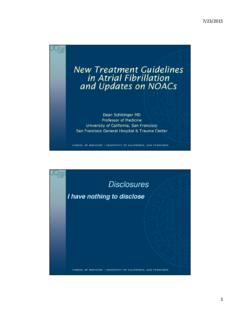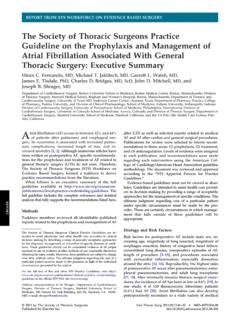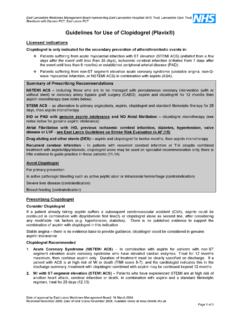Transcription of COMPLICATIONS OF ATRIAL FIBRILLATION ABLATION
1 COMPLICATIONS OF ATRIAL FIBRILLATION ABLATION . Carlo PAPPONE, MD, PhD, FACC. Vincenzo SANTINELLI, MD. Department of Arrhythmology, Villa Maria Cecilia Hospital, Cotignola, Ravenna, ITALY. Address for correspondence Carlo Pappone, MD. Villa Maria Cecilia Hospital Via Corriera 1. 48010 COTIGNOLA. Ph + Fax + 1. Catheter ABLATION COMPLICATIONS . Introduction Currently, catheter ABLATION can be considered as an effective treatment among patients with symptomatic ATRIAL FIBRILLATION (AF), but both feasibility and safety of the procedure are strongly required (1-9).
2 Due to its complexity as well as the significant length of time needed to successfully ablate all targeted areas in the left atrium, it is mandatory to define an acceptable risk-benefit ratio and how to avoid many of the serious COMPLICATIONS ( ). Although COMPLICATIONS rates of catheter ABLATION of AF are declining (1-3), they may nullify any mid-to-long-term benefit of the procedure. There are mechanical COMPLICATIONS resulting from catheter manipulation within the cardiac chambers, cardio-embolic COMPLICATIONS (stroke and transient ischemic attacks), and COMPLICATIONS arising from the effects of RF applications in the left atrium (pericardial effusion/tamponade).
3 The most frequent acute COMPLICATIONS arise from the vascular access, trans- septal puncture, and left atrium navigation and ABLATION , while incessant new onset atypical ATRIAL tachycardias are the most frequent late COMPLICATIONS . An evolving and better understanding of the procedure-related risks have helped to limit complication rates by changing ABLATION approaches to avoid RF applications within PVs or just at PV ostia, thus ensuring an appropriate anticoagulation during the procedure with an accurate monitoring, or by using 3D electro-anatomic mapping systems for an accurate reconstruction of intracardiac structures, and by recognizing COMPLICATIONS promptly both during and after the procedure.
4 Hopefully, improved techniques and operator'. experience in the next years will be useful to further improve both efficacy and safety of catheter ABLATION of ATRIAL FIBRILLATION to allow for continued growth of this procedure (Figures 2 and 3). At present, CARTO-guided left ATRIAL circumferential ABLATION ( of patients) and LASSO-guided ostial electric disconnection ( ) are the most commonly used techniques (1-3). Death is a very rare complication ( ) and in our experience based on > procedures this fatal complication has never occurred.
5 A detailed list of the different COMPLICATIONS of CPVA with their relative incidence is reported in Figure 4. Pre-procedural imaging techniques are routinely 2. performed in our Department to evaluate the left ATRIAL size, anatomy, and function as well as to exclude the presence of an ATRIAL thrombus. During the procedure, while fluoroscopy remains a useful modality for guiding both trans-septal catheterization and catheter navigation, several imaging modalities have been developed to improve 3D navigation and ABLATION within the cardiac chambers.
6 Post-operative imaging is used to monitor the heart function as well as to exclude potential COMPLICATIONS like pericardial effusion or pulmonary vein stenosis. While trans-thoracic echocardiography and fluoroscopy are mandatory for all patients in the context of AF ABLATION , the use of other imaging modalities depend on the single center experience. There must be a balance between irradiation reduction and procedural duration, improvement in catheter manipulation, cost- effectiveness ratio, and potential adverse effects of each imaging procedure.
7 Vascular COMPLICATIONS Periferal vascular COMPLICATIONS are usually considered as minor COMPLICATIONS and include hematoma, artero-venous fistula, and femoral pseudoaneuriosm. Major vascular COMPLICATIONS of the procedure are rare and include hemotorax, subclavian hematoma, and extrapericardial PV. perforation. Vascular COMPLICATIONS are detected during ABLATION by invasive blood pressure monitoring, oxygen saturation, and after ABLATION by pressure monitoring and blood exams. Management of vascular COMPLICATIONS consists in an aggressive approach to repair them while limiting anticoagulation (low ACT).
8 Trans-septal puncture Trans-septal puncture is required in patients undergoing AF ABLATION . Although this approach is safe in the majority of cases (> 99%), potential COMPLICATIONS may occur even in experienced hands. In up to 1% of cases trans-septal puncture is not feasible and the main reason for an unsuccessful puncture is related to fossa ovalis/ ATRIAL septum anatomy. The majority of the general population does not have a patent foramen ovale and, then, trans-septal puncture for access into the LA is required in most patients undergoing catheter ABLATION of AF.
9 Using the standard Brockenbrough 3. approach (with fluoroscopy only), a jump' is seen when pulling the trans-septal sheath down the septum, indicating the position of the foramen ovale. The needle position in relation to the septum can be checked in relation to catheters marking the His bundle and coronary sinus (CS), using orthogonal planes. Injection of contrast onto the septum may help in evaluating the exact location of the needle before advancing the dilator and the sheath. This method provides useful information to safely perform trans-septal puncture in most cases, but variations in the septal anatomy or adjacent structures may increase the risk of COMPLICATIONS .
10 Trans-esophageal echocardiography (TOE) can help to localize the septum, with tenting seen when the needle and sheath are pushed onto the foramen. The problem with using TOE is that the patient is in a prone position, making airway management difficult, often with the requirement of general anaesthesia. To overcome this problem, intra-cardiac echocardiography (ICE) is routinely used in some centres to facilitate an accurate definition of the region. Trans-septal puncture may be associated with puncture of adjacent structures such as aortic root, right ATRIAL posterior wall, coronary sinus, and circumflex artery.








